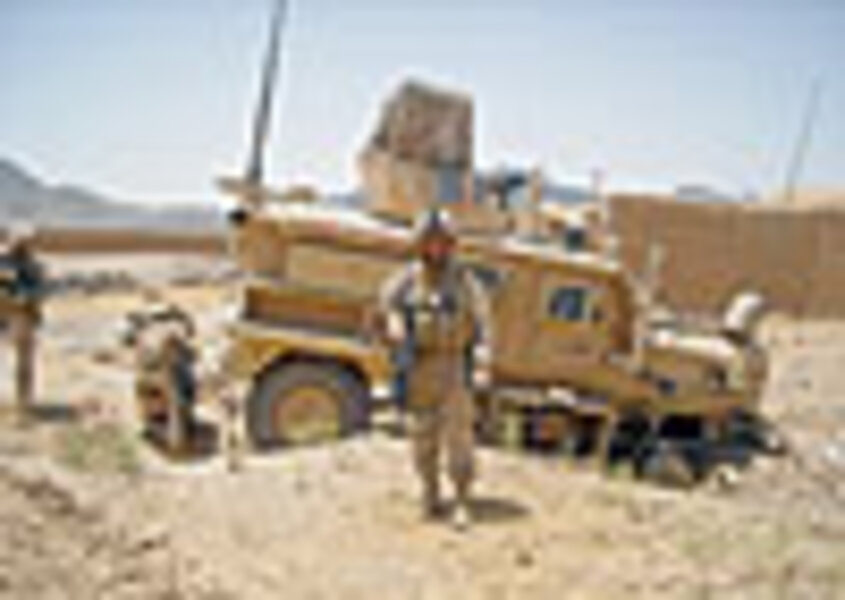MRAP trucks: Afghan savior or boondoggle?
Loading...
| Washington
It took a matter of seconds to make 1st Sgt. Eric Rummel a true believer.
The marine was driving through southern Afghanistan last year when his truck hit a roadside bomb buried in a gulch. The vehicle shuddered, popped into the air, and settled back down again in a cloud of desert dust.
The whole thing was over before he knew what happened, but Sergeant Rummel and the two other men in the truck that day all walked away. The truck was a Mine Resistant, Ambush Protected truck (MRAP) – a 16-ton behemoth that came to be regarded as the soldier's lifeboat in Iraq, its V-shaped hull saving lives by deflecting the blast of roadside bombs.
Rummel's story points to the same success in Afghanistan. "God bless the MRAP and what it does," he says.
But the mammoth trucks are built for Iraq, where troops are fighting a largely urban insurgency on city streets. Afghanistan's insurgency is rural, and the Pentagon is in a race to completely redesign the MRAP for its new duty, making it lighter, with a beefier suspension and better off-road capabilities for troops who launch missions into fields and up hillsides – often with no roads.
The effort, however, calls into question one of the bedrock tenets of Defense Secretary Robert Gates's regime: He wants to prioritize equipment that saves troops' lives. But experts wonder if, in the process, he is saddling the military for years to come with a fleet of vehicles that can be used in only one spot on the globe.
"It's not so clear that we can develop a new class of vehicles every time we go to a new country," says Loren Thompson, chief operating officer of the Lexington Institute, a policy group in Washington.
The initial program to come up with a new breed of Afghan-friendly MRAPs, called Multi-Purpose All Terrain Vehicles, or M-ATVs, will cost $2 billion. The MRAP program has produced more than 16,000 vehicles in two years. This month, the Pentagon is expected to finalize a contract that would put more than 2,000 M-ATVs in Afghanistan – some by this fall.
The logic is clear: Roadside bomb attacks in Afghanistan are up some 80 percent over last year.
The day Rummel's truck was hit, he was using his MRAP as an ambulance to evacuate war wounded near the town of Now Zad in Helmand Province in southern Afghanistan, an area of intense fighting. Before his truck had even arrived in the gulch, four other improvised explosive devices had detonated in that area; two marines later needed amputations.
The explosion surprised Rummel, particularly because the Humvee in front of him had just driven through the same gulch unscathed.
As much as he loves the truck that protected his life, Rummel says the current MRAP isn't the right truck for Afghanistan, adding: "It's just too big of a vehicle."
Pentagon planners agree. They "are convinced that the terrain and infrastructure in Afghanistan vary so greatly from Iraq that a different class of heavy trucks is required," says Mr. Thompson of the Lexington Institute.
Within the armed forces, however, there is skepticism about the need for M-ATVs. Gen. James Conway, commandant of the Marine Corps, isn't committing to the new $1 million-a-copy truck yet. He wants to determine if a faster, cheaper modification to one of the existing MRAP models might make it "Afghan-worthy."
In theory, the modification is an interim measure to tide over the Marines until the new MRAPs arrive. But the temporary solution could become a long-term fix.
After years of being stuck in Iraq, the Marines are trying to return to their expeditionary roots. They are increasingly worried about the weight and size of some of the new vehicles, which would make them difficult to stow aboard ships and cargo planes. The safety specifications of the new M-ATV may add so much weight that they literally tip the scales, leading the corps to pass on the vehicle, General Conway said.
Four companies have submitted five M-ATV prototypes for consideration, and each is undergoing testing at the Aberdeen Proving Grounds outside Washington. Pentagon officials expect to choose one vehicle by the end of this month or in early July, defense officials say.
The effort has its roots in Mr. Gates's first weeks in the Pentagon more than two years ago. He arrived to find that many troops in Iraq were still driving in Humvees and other vehicles ill-suited to protect against roadside bombs. A new truck became his chief acquisition priority.
Since then, Gates has broken new ground, creating a task force that essentially skirted the stodgy defense industrial complex and its bureaucratic impediments to get the truck built quickly and shipped to Iraq.
In the process, however, he also spent billions to create a truck that may be useless in other types of environments.
"It really is a situation of damned-if-you-do, damned-if-you-don't," says Dakota Wood, a retired Marine lieutenant colonel who is now a senior fellow at the Center for Strategic and Budgetary Assessments, a think tank in Washington.
"People who hit a roadside bomb in an MRAP typically walk away, but that comes with a cost" to the military's broader strategic capabilities, he adds.
Money is another factor. The Pentagon had the cash to build and field the MRAP quickly. But defense dollars are beginning to shrink, and defense officials will have to make wise spending choices. The popularity of the MRAPs among troops, Congress, military leaders, and the American public will make it a sacred cow no one wants to be seen as opposing.
For his part, Rummel hopes that whatever truck the Pentagon sends to Afghanistan, it's one that can keep saving lives.
"I truly believe in it, I really do," he says.






